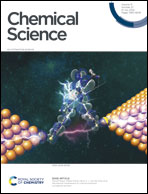Building an emission library of donor–acceptor–donor type linker-based luminescent metal–organic frameworks†
Abstract
Luminescent metal–organic frameworks (LMOFs) have been extensively studied for their potential applications in lighting, sensing and biomedicine-related areas due to their high porosity, unlimited structure and composition tunability. However, methodical development in systematically tuning the emission properties of fluorescent organic linker-based LMOFs to facilitate the rational design and synthesis of target-specific materials has remained challenging. Herein we attempt to build an emission library by customized synthesis of LMOFs with targeted absorption and emission properties using donor–acceptor–donor type organic linkers. By tuning the acceptor groups (i.e. 2,1,3-benzothiadiazole and its derivatives), donor groups (including modification of original donors and use of donors with different metal–linker connections) and bridging units between acceptor and donor groups, an emission library is developed for LMOFs with their emissions covering the entire visible light range as well as the near-infrared region. This work may offer insight into well controlled design of organic linkers for the synthesis of LMOFs with specified functionality.



 Please wait while we load your content...
Please wait while we load your content...